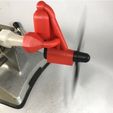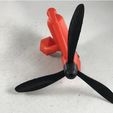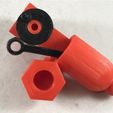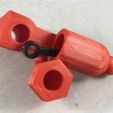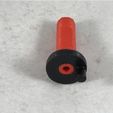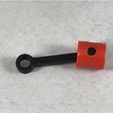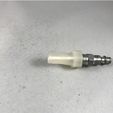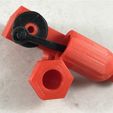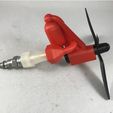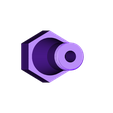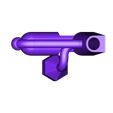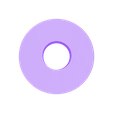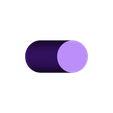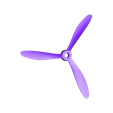How I Printed and Assembled Model Aircraft Styled Air Engine, Experimental.
Print the Parts.
Print one each of the parts.
I printed "Axle Propeller.stl", "Propeller 3 Blade.stl" and "Spinner.stl" with 100% infill and a .15mm layer height.
I printed the remaining parts at 20% infill and .15mm layer height.
"Block.stl", "Propeller 3 Blade.stl" and "Spinner.stl" must be printed with supports.
I printed my block using red PLA with natural PVA for support using a Cura 3.0.4 support overhang angle setting of 40. At this setting, Cura 3.0.4 also places PVA support material inside the air passageways which, after printing, will dissolve in a water bath. When not using PVA (or dual extrusion), make sure the slicer does not place support material in the air passageways as it will not be accessible for removal after the print is completed, thus the engine will not work.
I printed my propeller and spinner with a Cura 3.0.4 support overhang angle setting of 60. Check your slicer for the best settings for your printer.
Prior to assembly, test fit and trim, file, sand, etc. all parts as necessary for smooth movement of moving surfaces, and tight fit for non moving surfaces. Depending on the colors you chose and your printer settings, more or less trimming, filing and/or sanding may be required. Carefully file all edges that contacted the build plate to make absolutely sure that all build plate "ooze" is removed and that all edges are smooth. I used small jewelers files and plenty of patience to perform this step.
"Piston.stl" and "Axle Propeller.stl" must slide / rotate respectively smoothly but not "loose". If these two parts are too tight, the engine will not operate, and if too loose, excess bypass air will escape and degrade engine performance.
This design uses threaded assembly, thus a 6mm by 1 tap and die may be needed to clean the threads.
Assembly.
Place the small end of "Rod Piston.stl" into "Piston.stl", then secure the rod in place using "Pin Piston.stl" as shown.
Thread "Axle Propeller.stl" into "Journal.stl", carefully noting the final orientation of the axle in regard to the pin on the journal as shown. This is important as it controls the timing of pressurized air into the cylinder as well as the exhaust air from the cylinder.
Slide the piston assembly into position in "Block.stl" as shown.
While carefully flexing the piston rod to the side, slide the axle assembly into the block, then place the large end of the axle over the pin on the journal as shown.
Place "Spinner.stl" into "Propeller 3 Blade.stl" then thread it into the axle as shown.
Thread the 1/4" compressor adapter into "Adapter Compressor.stl" as shown, then thread this assembly into the block as shown.
Operation.
Always wear appropriate safety equipment (safety glasses, face shield, etc.) when operating this model.
Connect the model to a compressor using a quick disconnect.
Set the compressor air pressure to around 5PSI.
Spin the propeller counter clockwise (as viewed from the front of the model) as shown in the video. If the model doesn't start, slightly increase the pressure and try again.
That's how I printed and assembled Model Aircraft Styled Air Engine, Experimental!
Hope you like it!
To be continued...

/https://fbi.cults3d.com/uploaders/13550170/illustration-file/3061a31d-87be-4326-a507-432b2793e726/48c62995bfe40001468f0d48af153393_preview_featured.JPG)









